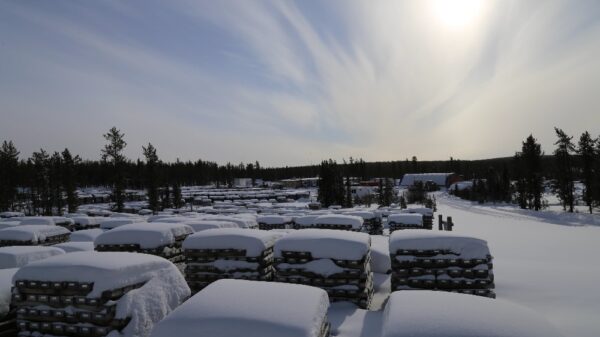ALX Resources Corp. (TSXV: AL) (FSE: 6LLN) (OTC: ALXEF) completed its 2024 winter drilling campaign at Gibbons Creek Project in the northern Athabasca Basin close to the community of Stony Rapids, Saskatchewan.
The company designed this year’s program to test continuity of uranium mineralization first discovered in 1979 by Eldorado Nuclear and ALX in 2015. ALX announced on Thursday that it had drilled five holes at 849.44 meters, and four of the five holes intersected uranium mineralization either or or near the uniformity.
In 2024, drilling intersected mineralization in two areas located 500 metres apart within a target area that ALX defined in late 2023 by conducting a high-resolution magnetic survey and a Soil Gas Hydrocarbon survey.
Hole GC24-04 delivered the strongest radiometric response of the program, intersecting uranium mineralization over 1.1 metres from 107.17 to 108.27 metres, beginning immediately at and below the unconformity at 107.18 metres.
Hydrothermal activity had strongly bleached the Athabasca formation sandstone immediately above the mineralization, changing it from an unaltered dusky maroon colour to white. A Mount Sopris 2PGA-1000 downhole gamma probe recorded a radioactive peak of 8,662 counts per second (cps) within the mineralized interval. This revealed black blebs of uranium mineralization embedded in dark red hematite alteration, closely associated with lesser amounts of yellow limonite alteration.
ALX Resources drilled Hole GC24-05 using the same setup as GC24-04 by tilting the drill head following an in-field interpretation of a possible fault offset of the unconformity. It then found blebs of black uranium mineralization at 103.4 to 103.5 meters.
Read more: ATHA enters C$8M option agreement with Inspiration Energy for Saskatchewan assets
Read more: ATHA Energy closes acquisition of Latitude Uranium, obtains Nunavut and Labrador properties
Previous month was tenuous for uranium
The previous month was fairly tenuous for uranium, according to Sprott Asset Management.
The uranium market went through some ups and downs in March. The spot price of U3O8 fell 6.84 per cent, going from US$94.60 to $88.13 per pound. But uranium miners and junior miners actually went up. They rose 1.75 per cent and 2.52 per cent, respectively.
The recent price action in the uranium spot market suggests that it might be hitting a bottom. In the first half of March, the spot price went down and hit a low of $83.78. But then it started to go back up, and by the end of the month it was back up to $88.13 per pound.
One big reason why the spot market has been acting this way is because some utilities and producers decided to hold off on buying uranium. This is called a “buyer’s strike.” It happened because the price went over $100 per pound.
Furthermore, nuclear power plants buy fuel differently than other kinds of plants, like natural gas plants.
Natural gas plants need to buy fuel all the time. But nuclear plants can store fuel for several years. Because they have uranium stockpiled in their reactors and throughout the fuel cycle, utilities can afford to wait to buy more if they don’t want to pay a high price.
This is fortunate as there is a sizeable imbalance between supply and demand as it pertains to uranium.
Read more: ATHA completes 92 Energy acquisition; prepares for drill program at Gemini project in Q3
Read more: ATHA Energy expands into new Canadian territory with 2024 exploration program
Supply crunch bodes well for Canadian uranium
The uranium market is currently facing a supply crunch.
While demand is rising due to factors like growing reliance on nuclear power and the emergence of next generation technologies, supply hasn’t kept pace. Mine production cuts due to unfavourable pricing and Kazatomprom, the world’s largest producer, experiencing flooding issues are contributing factors.
Additionally, the usual buffers from stockpiles and recycled materials are dwindling. This imbalance is pushing uranium prices higher, with investors entering the market for potential gains, further tightening supply.
That means nuclear facilities in the United States and beyond may need to look beyond its traditional sources to meet demand, which may include a stronger reliance on companies from regions like the Athabasca Basin.
This bodes well for companies like Cameco Corporation (NYSE: CCJ) (TSX: CCO), which has already admitted to straining with the increased requirements. Fortunately, other basin oriented companies like Denison Mines Corp. (TSX: DML) (NYSE: DNN) and ATHA Energy Corp. (CSE: SASK) (FRA: X5U) (OTCQB: SASKF) are present to pick up the slack.
ATHA Energy Corp. is a sponsor of Mugglehead news coverage














